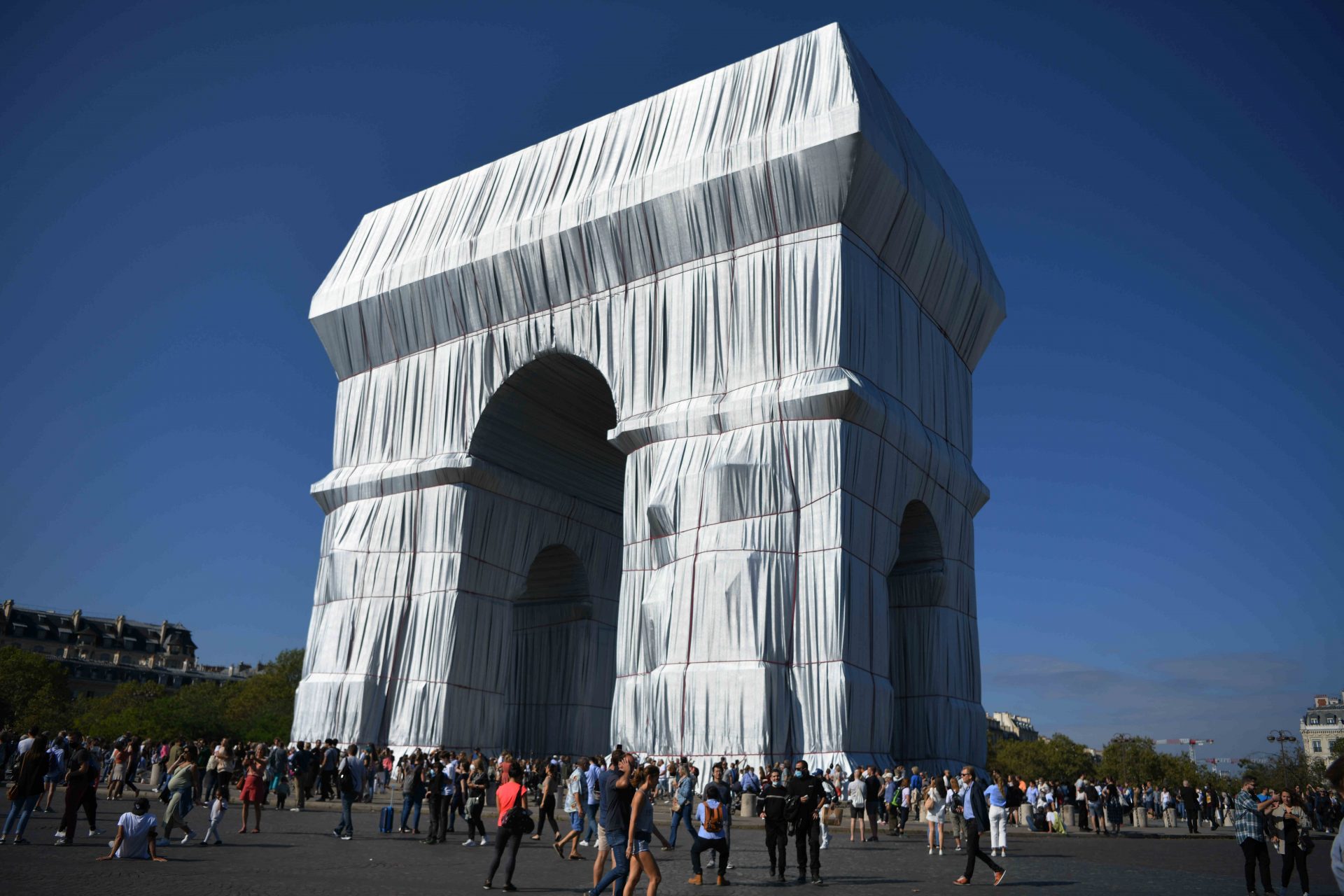Visual artists don’t usually produce new works from beyond the grave. But there is now at least one major exception.
This month the wrap artist known as Christo, who died in May 2020, managed to cover Paris’s Arc de Triomphe in blue recyclable polypropylene fabric – 25,000 square metres of it. No mean feat.
Christo left detailed plans for this posthumous work, calling it somewhat prosaically L’Arc de Triomphe, Wrapped. His team had all the information about his intentions they needed. And now it has been realised. This is the real Christo, a cover but not a cover version.
Christo is more accurately ‘Christo and Jeanne-Claude’ – the combination of the Bulgarian-born artist Christo V. Javacheff and his partner from Morocco, Jeanne-Claude de Guillebon.
They achieved great fame with their audacious public art. Most of this was self-funded by sales from sketches, photographs, and plans for their works, which usually involved completely covering emblematic buildings.
The best-known was realised in 1995 when they encased Berlin’s Reichstag in silvery fabric for two weeks, after decades of failing to get permission. They’d managed to give Paris’s Pont Neuf the wrap treatment ten years earlier.
Their work is deliberately ephemeral – once the building has been unwrapped, that’s it. And it can’t be bought or sold. Nor can anyone charge an entry fee – this is public art for the people.
Sceptics might ask, “why this is art?” A building covered in plastic and tarpaulins to stop rain coming in isn’t magically transformed into a work of art, so why should Christo’s interventions be treated with such reverence?
Philosophers of art have pondered this sort of question ever since Marcel Duchamp entered a urinal signed ‘R. Mutt’ for an open exhibition in New York in 1917, calling it Fountain. What made that urinal so different from the almost indistinguishable urinals found in public toilets?
A simple answer, suggested by the American philosopher Arthur Danto and elaborated by George Dickie, known as the Institutional Theory of Art, is that visual art is not entirely visual: it involves relations between artworks and their particular histories. You can’t tell if something is or isn’t a work of art just by looking at it.
Typically, an artist presents some kind of artefact as a ‘candidate for appreciation’, invites us consider it as a work of art. According to Dickie, artists have something akin to the Midas Touch and just by designating something art in this way they change its status.
It’s a bit like when a couple gets married – someone with the appropriate authority declares them married and then they are married. An identical-looking couple which hasn’t been through that ceremony isn’t married. You can’t tell just by looking at them which is which.
The Midas Touch analogy shouldn’t be taken too far though. Dickie makes very clear that just because something is a work of art, it doesn’t mean that it has great artistic value. As he put it, “One can make a work of art out of a sow’s ear, but that doesn’t necessarily make it a silk purse”.
The question of whether it is a good work of art or not is a further one. But if you want to know whether Christo’s posthumous wrapping of the Arc de Triomphe is a work of art or just an ordinary ceremonial arch covered in drapes, then according to his theory it definitely is art because an artist invited us to see it that way.
But that leaves open the question of whether it is a good work of art or not, a more important question, perhaps. In this case, what might be Christo’s final work is definitely at least good if not great.
It’s not just a remarkable feat of persistence and will for an artist-couple to overcome all the obstacles to commandeering a public building like this for 16 days – something that took nearly 60 years to achieve from idea to execution. It’s also beautiful – a traditional quality of visual art.
It changes the way we see a Parisian landmark, giving it an air of mystery and presence that it never had before. It has a dream-like surreal quality, making the familiar strange to us.
There can’t be many more Christos in the pipeline. This may well be the last. The day will soon come when the Christo team will have to admit to themselves that it’s all over.
At which point I doubt they’ll be able to resist the temptation to declare: “It’s a wrap.”



